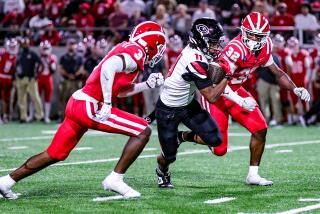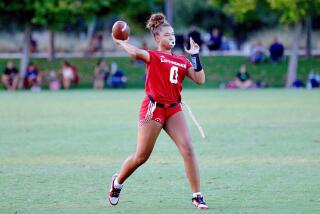Chapman Tries to Reignite Gridiron Spirit : Sports: Will students rally behind the O.C. university’s first football team since the 1930s?
ORANGE — The last time the Chapman University Panthers football team ran out onto a field, Franklin D. Roosevelt had just been elected and the New Deal promised relief to a nation mired in the Great Depression.
Sixty-two years later, players will once again don helmets and pads and march onto the gridiron this September. This time, the team will play home games in Orange--not Los Angeles--and will no longer carry its old name of California Christian.
Boosters are quick to mention that the Chapman Panthers will become the only NCAA football squad in Orange County when they battle the Whittier College Fighting Poets on Sept. 17.
Just a few small problems, though.
Most team members haven’t met each other yet. A recently ordered scoreboard remains to be installed. And someone’s going to have to tutor the university president on the intricacies of the game.
“I may have to read a rule book,” President James Doti said.
But the bigger question at this school of about 2,900 students--few of whom are aware of the school’s long-lost football heritage--is whether Chapman students will rally behind the team and gain school spirit.
Maybe part of it is having a fight song, like USC’s “Fight On” or the University of Michigan’s “Hail to the Victors.”
“Do we have a school fight song?” Athletic Director David Currey asked himself. “We don’t even have a school fight.”
OK, so maybe it’s going to be harder than they thought. But team supporters said they’re ready to make Chapman’s first football season in Division III the NCAA small-college category--a memorable one by involving 100 new football players and the rest of the student body in the process.
“It’s exciting to be a part of history,” said head coach Ken Visser. “Maybe this isn’t the most significant thing in history, but for a football player, it’s pretty exciting to be a part of something that hasn’t existed in 62 years.”
Sports psychologists and experts said there are several factors that can rally students and alumni behind a team and develop school spirit: image, marketing, tradition and, of course, winning.
“Apathy is a function of poor performance,” explained Dr. Robert Schleser, director of the Center for Sport Performance Psychology in Chicago. “An institution with history and tradition can sustain losing better than a new program.”
If the team doesn’t win, some people think fans will quickly lose interest.
“I have clients who say, ‘Yeah, I hear you got a football team,’ and they smirk and laugh,” said Jennifer Trammell, 23, a hairstylist and English student at Chapman. “They expect them to lose.”
Trammell said she plans to attend the games, which will be free to students and faculty. Tickets will cost the public $5.
“This is not a revenue sport--it’s a participation sport,” said Currey, adding that it will cost the university about $200,000 to fund the team. None of the players will receive scholarships.
“It’s the way it was years and years ago,” Currey said.
Creating nostalgia, sticking with the basics of a sport and starting tradition may be a part of boosting spirit, experts said. Part of that tradition revolves around football’s role as a part of Americana and college life.
“One of the things that’s distinctive about American colleges and universities is this notion of school spirit,” said Mike Oriard, an English professor at Oregon State University who played football at Notre Dame and for the Kansas City Chiefs. “Here we think of college as a way of life for four years, an experience not just in curriculum but in athletics and its spinoffs.”
Chapman administrators think having the football players tap the head of a donated $8,000 bronze panther sculpture on campus before each Saturday game might start a tradition. At some other colleges, players tap signs before games or pray together in special alcoves.
Chants, events such as homecoming and rituals such as Florida State University’s “Tomahawk Chop” are mentioned as a few of the customs that help fans identify themselves with a team.
“Football gives people a sense of pride, a sense of belonging,” said Schleser, a psychology professor at the Illinois Institute of Technology. “Teams become an extension of ourselves and bring us together as a group.”
Marketing can promote and reflect how students and alumni rally behind a team.
Chapman bookstore manager James Clement said the store began stocking football-themed shirts in late spring, with lackluster sales. They also have big, red Chapman flags available, “but you don’t find too many people with flagpoles,” Clement said.
He expects sales to pick up when new sweat shirts and other items arrive in the fall.
“The spirit’s already here,” Clement said. “Having a football team’s really going to boost it.”
Trammell believes administrators need to promote the team more, because she has not heard enough about it at school. A member of the Alpha Phi sorority, she plans to be a part of any spirit activities that form around the team.
“But they really need to rally school spirit,” said Trammell, of Anaheim Hills. “It’s a private school and really well-known, but not for sports.”
On a recent afternoon, Currey, the athletic director, had a unique Chapman football item on his desk that may whip up some spirit during the countdown to the opening day.
A black plastic digital watch marked with a red “C”--destined to go to selected people in the Chapman community--lay in its box, but the words on its face were visible: 33 days till Panther football .
Bob Topor, a higher education marketing consultant, said excitement about a college can easily be packaged.
“This idea of spirit has monetary value, just as a product may have inherent value in terms of public visibility,” Topor said.
Visser, Chapman’s new coach, thinks location will help the team. “We’re in Orange County, and Orange County loves football,” Visser said.
Then there’s Doti, Chapman’s president and an economist, who came up with the idea to revive the football team even though the two schools he attended--the University of Chicago and the University of Illinois at Chicago Circle--did not have football teams.
Doti and other administrators moved the school’s athletics program from Division II, where its teams faced larger schools, to Division III in 1992--much to the dismay of some in the athletic department. That meant no more scholarships, but it also meant that two new men’s sports and five new women’s sports could be added because the department had more money.
“Now we’re the only game in town,” Doti said. Neither UC Irvine nor Cal State Fullerton, the two largest Orange County universities, have intercollegiate football programs.
“And with the possibility of the Rams leaving, people are enthusiastic,” he said.
Cal State Fullerton physical education professor Kenneth Ravizza said he doubts Chapman will be able to rally large numbers of students to support its team. Cal State Fullerton disbanded its Division I football team in 1992.
“With Division III schools, their quality of entertainment isn’t good,” Ravizza said. “But they’re not there to entertain the fans, they’re there to provide opportunity for a student athlete.”
One sports historian called Division III football closer to the “pristine ideal” of the sport. Currey agreed.
“We want to bring back the days when you studied, and you played for fun,” he said.
Doti said alumni and others are already asking him about the team. He said listeners regularly approach him to ask questions after his speeches on economics but “now sometimes people walk up and instead of asking about inflation, they say, ‘Are you really going to have a good team?’ ”
Banners soon to be strung throughout campus and in the streets of downtown Orange will remind the community of the first big home game against Claremont College Sept. 24, said Chapman spokeswoman Ruth Wardwell.
In a nostalgic opening to the game, Ernie Chapman, 84, reportedly the last remaining living player from the days of 1930s Chapman football, will handle the coin toss that determines which team kicks off first. He is the son of university founder Charles C. Chapman.
“How’s that for tradition?” Wardwell said.
Fans are also scheduled to get Chapman seat cushions.
Novelty likely will draw fans to the 3,000-seat stadium at first, officials said. But as a precaution, they have rented grandstands used at the Rose Parade and Long Beach Grand Prix in case projected attendance exceeds the stadium’s capacity.
Because Chapman moved to its current campus from Los Angeles in 1954, its stadium has never seen college football.
The field, set to be striped for the first time this morning by a grounds crew from Anaheim Stadium, is spare and undecorated, lacking the history that is part of great football tradition. There’s nothing like “Touchdown Jesus,” the mosaic that overlooks Notre Dame’s stadium and is a symbol of that university’s football fever.
On opening day, the horns and drumbeats of a loud university marching band will also be missing. A pep band of music students from Chapman is still in its formative stages, Currey said. The recent departure of the school’s cheerleading adviser also has left officials unsure whether a pep squad can be ready for the season opener.
That’s to be expected at the start of a small, new program, Currey said. It’s also peripheral to his central goal: a good game of football.
“We haven’t built a brand new stadium or fancy chair backs,” Currey said. “We haven’t got fancy brochures or season tickets or deluxe boxes.
“What we do have is a college team that’s going to run out onto the field and play.”
More to Read
Go beyond the scoreboard
Get the latest on L.A.'s teams in the daily Sports Report newsletter.
You may occasionally receive promotional content from the Los Angeles Times.










